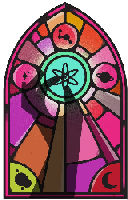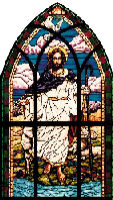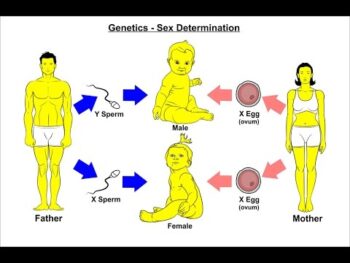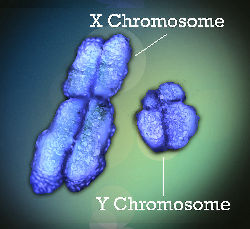Could Mary, mother of Jesus, really have been a pregnant virgin? Although a basic tenet of Christianity, many still find the virgin birth a stumbling block in their faith. We will take a scientific look at this extraordinary event.
This is an article that has been in the making for twenty-five years. Well, not continually, but the idea started that long ago — the actual writing had to wait, because I just didn’t know where to start my research back in the 1990s. Over the years since then, I slowly began going down a rabbit hole looking for evidence of how a virgin birth could be possible. Not much was there, but it did lead me to plenty of other things I could write about.
To begin a journey that gets increasingly weird, problematic, and complex, is similar to the story Alice’s Adventures in Wonderland by Lewis Carroll. Hence, researching such a story is sometimes referred to as “going down a rabbit hole.” The evidence was minimal at first, but as things appeared, I built a file of related events, research, and ideas.
One turning point toward progress was contact with an Australian researching the same idea as mine (more about that later) and the final push to writing this article was reading a new book, just published, by author David Instone-Brewer, titled Science & the Bible: Modern Insights for an Ancient Text.
Some of what I write references Instone-Brewer’s book, but I do not want to imply that anything I say can be considered his thoughts on the matter; his scientific approach only inspired me to express my own rather unconventional opinions.
A Virgin Birth
 Jesus was born from Mary, a virgin, through the power of God’s Holy spirit, without a human father. Read all about it in Matthew and Luke. Not only was this miraculous, but even predicted beforehand (Isaiah 7:14). He was both godlike and human (Colossians 2:9).1 If Jesus was sent to die for the sins of humankind, he had to be born sinless, as Adam was before the fall, in order to purchase back the everlasting life lost by Adam. In other words, another perfect life was needed to be sacrificed for the exchange to be completed. (A previous article gives more details about this exchange. See References & Notes.)2
Jesus was born from Mary, a virgin, through the power of God’s Holy spirit, without a human father. Read all about it in Matthew and Luke. Not only was this miraculous, but even predicted beforehand (Isaiah 7:14). He was both godlike and human (Colossians 2:9).1 If Jesus was sent to die for the sins of humankind, he had to be born sinless, as Adam was before the fall, in order to purchase back the everlasting life lost by Adam. In other words, another perfect life was needed to be sacrificed for the exchange to be completed. (A previous article gives more details about this exchange. See References & Notes.)2
And any sacrifice offered to God must be without blemishes. This was a requirement (Numbers 19:2; Deuteronomy 17:1). To be born of imperfect human parentage only, would imply Jesus was of a sinful nature and that would be a blemish.3 Atonement requires an unblemished sacrifice. Therefore, implantation of a perfect embryo within a virgin human womb would complete all scriptural requirements.
Now, I do not hold to the perpetual virginity belief of Orthodox and Roman Catholic churches, as well as some Protestant leaders (e.g., Martin Luther, John Wesley, John Calvin).4 The Bible states that Jesus’ mother did have other male children — James, Joseph, Judas, and Simon, as well as unnamed girls. “Is not this the carpenter’s son? Is not his mother called Mary? And are not his brothers James and Joseph and Simon and Judas? And are not all his sisters with us?” (Matthew 13:55-56, NRSV).5
But, isn’t a virgin birth scientifically impossible?
 So, aren’t virgin births impossible? It used to be thought so, but not anymore. Oh, how marvelous was the time when people believed only because of their faith. But, there is now scientific research to backup this claim, for those who may have had doubts before.
So, aren’t virgin births impossible? It used to be thought so, but not anymore. Oh, how marvelous was the time when people believed only because of their faith. But, there is now scientific research to backup this claim, for those who may have had doubts before.
I’ll have to get a bit technical, before I can establish my train of thought, but bare with me. If you get bogged down in too much science, just skip past the technical paragraphs. But keep in mind that I have never thought that science is the enemy of faith, but that science and Christian doctrine can be accommodated together.
 Also, I have always believed that God set up this universe with specific physical laws to frame the reality in which we live, and he uses those same laws to interact with us. A miracle is only something being accomplished in a way that we do not yet understand, but they still occur by way of God’s established physical laws of nature. Many of the Bible’s miracles have now been explained by science.
Also, I have always believed that God set up this universe with specific physical laws to frame the reality in which we live, and he uses those same laws to interact with us. A miracle is only something being accomplished in a way that we do not yet understand, but they still occur by way of God’s established physical laws of nature. Many of the Bible’s miracles have now been explained by science.
Natural reproduction without a father is called parthenogenesis (par•the•no•gen•e•sis). It is from the Greek: parthenos meaning ‘virgin’ and genesis meaning ‘creation’. It means embryos produced without fertilization by sperm. It normally occurs in some few animals, but not so in humans. Sometimes an unfertilized human egg can develop into an early stage embryo, but such an event ends with the embryo being rejected by the womb. But a method for possible successful virgin birth was discovered in 2004, when a new approach was tried and a viable embryo was produced.
Although an astounding achievement in itself, the embryo was not allowed to come to term and wasn’t even reported at the time. The scientific team, led by South Korean Hwang Woo-Suk, fraudulently used the method to create a clone. Rather than take the added time necessary for proper cloning, they found it simpler and faster to perform parthenogenesis.6 It could possibly have produced a virgin birth, if the process had been actually performed on a woman who had never had sexual intercourse.
“In the course of his research, which was carried out with false claims that stem cells had been extracted from a cloned human embryo, his team succeeded in extracting cells from eggs that had undergone parthenogenesis.” This research ‘shortcut’ was uncovered by Harvard and Cambridge geneticists who analyzed the Korean scientist’s results. Although fraud was found, Hwang Woo-Suk “unwittingly made a sought-after stem cell breakthrough.”7
Some researchers believe that, although rare, there may be natural cases of parthenogenesis — we are just unaware of them.8 British geneticists describe the case of a three-year-old boy with mild learning disabilities, whose X chromosomes9 in his blood, were all identical. This meant that the X chromosomes in all his blood cells, being identical, had to derive entirely from his mother. If nothing else, this proved unfertilized eggs are not always blocked and human parthenogenesis can occur.10
An author at the University of Texas also wrote, “Parthenogenetic reproduction could occur among human females yet remain unnoticed. Indeed, such a woman could have a husband and be totally unaware of her own condition. She would have only daughters, each of which would carry only her genes. . . . ”11
 Males have X and Y chromosomes, whereas females have two X chromosomes (XX). However, there is a condition where someone with XX chromosomes can be actually born a male. This happens in about one in twenty thousand male births — which means that about eight thousand men living in the United States today have XX chromosomes, just like women do.12
Males have X and Y chromosomes, whereas females have two X chromosomes (XX). However, there is a condition where someone with XX chromosomes can be actually born a male. This happens in about one in twenty thousand male births — which means that about eight thousand men living in the United States today have XX chromosomes, just like women do.12
We don’t hear much about these cases since men are unlikely to tell their friends. And, actually, they may not even know about it themselves, because they often look identical to other men. Some are born with sexual uncertainty, so their condition is diagnosed at birth, but it may not be discovered until later, during tests for other things such as abnormal development or infertility. Some, however, are never diagnosed, because they may have normal levels of testosterone so that they look and feel like ordinary men.13
There is, of course, artificial insemination, but a true virgin birth must occur without addition of semen from any means, not just a lack of sexual intercourse. I would guess that there is much successful experimentation in this field, even if only in secret. But one published report was made about a cloned human embryo being produced from a skin cell.14 And scientists in Australia have discovered how to fertilize eggs using genetic material from any cell in the body. “Theoretically, it also could mean that lesbian couples could give birth to a baby girl without the need for a father.”15
 While research continues to make great progress, the only successfully reported human parthenogenesis in the laboratory, to date, has resulted in embryos with some growth problems. But better success seems near, if not already achieved. Normally, one would expect this to result in a female baby, though a male is a statistical possibility.”16
While research continues to make great progress, the only successfully reported human parthenogenesis in the laboratory, to date, has resulted in embryos with some growth problems. But better success seems near, if not already achieved. Normally, one would expect this to result in a female baby, though a male is a statistical possibility.”16
Science has once more made the impossible, possible. And as far as Jesus’ birth is concerned, God would have had no problem manipulating his own natural laws to craft a parthenogenetic fetus for implanting within Mary’s womb. Today we call that genetic engineering. And, let’s face it, God had already done the same thing in the Garden of Eden, to build Adam and then Eve.
Some other academics and authors have also considered this idea. An article from Acts & Facts Magazine stated that Jesus’ body was formed from neither the seed of the man, nor the egg of the woman, but was grown from a unique seed planted in the woman’s body by God. That is, “God directly formed a body for the second Adam [Jesus] just as he had for the first Adam (Genesis 2:7).”17
Can a man, Jesus, understand a woman’s point of view?
A different, but related, question has also been raised and that is, “Can Jesus realistically be expected to represent women, since he was born as a man?” Well, if a man (usually with XY chromosomes) can instead be born with only XX chromosomes (as with women), or with XXY (or XXYY, or any other combinations reported),18 who could have really understood Jesus’ physiology or genetic makeup at the time, when his appearance was as a man.
 Many years ago, when I was the editor of a religious journal, I communicated with a gentleman reader living in Australia. He was working on the theory that Jesus was both male and female, like Adam prior to the creation of Eve. He died before he could complete a biblical thread for his proof. But I often thought of his idea and, now that science has advanced so much, there appears to be gems of that theory shining through the surface of genetic research.
Many years ago, when I was the editor of a religious journal, I communicated with a gentleman reader living in Australia. He was working on the theory that Jesus was both male and female, like Adam prior to the creation of Eve. He died before he could complete a biblical thread for his proof. But I often thought of his idea and, now that science has advanced so much, there appears to be gems of that theory shining through the surface of genetic research.
When Adam was first created in the Garden of Eden, he had both male and female attributes, before God separated his characteristics into both individual male and female parts. So, was Jesus’ body an exact copy of Adam’s? In 1 Corinthians it does say, “The first man, Adam, became a living being; the last Adam became a life-giving spirit” (1 Corinthians 15:45).
It seems reasonable to believe Jesus could understand from both male and female points of view. And, indeed, his biblical story shows evidence that he was quite ‘tuned-in’ to a woman’s basic inherent qualities and characteristics. (For more information on the creation of Adam, and then Eve, see the article titled “Did God Really Make Eve from Adam’s Rib?” listed in References & Notes.)19
Finally, in Closing . . .
The music selection for this article is ‘The Virgin Mary Had a Baby Boy’. This is a West Indies Negro Spiritual taken from the scripture in the books of Matthew and Luke. The song was written down as received from James Bryce in 1942, when he was 92 years old.20 This video is from a BBC Christmas presentation. Selected lyrics are below and the music video link can be found in References & Notes.21
 The Virgin Mary had a baby boy,
The Virgin Mary had a baby boy,
And they say that his name is Jesus.
He came from the glory,
He came from the glorious kingdom.
The angels sang when the baby was born,
And proclaimed him the Savior Jesus.
The wise men saw where the baby was born,
And they say that his name was Jesus.
![]()
Copyright © 2020, Dr. Ray Hermann
OutlawBibleStudent.org
→ Leave comments at the end, after ‘References & Notes’.
You can see our basic rules for comments by clicking “The Fine Print” on the top menu bar.
Reference & Notes
- Slick, Matt, “Why is the virgin birth of Jesus so important?” (CARM, Christian Apologetics & Research Ministry, 16 July 2016), https://carm.org/why-is-the-virgin-birth-of-jesus-so-important
- Hermann, Ray, “What do you mean, Christ died for our sins?” (The Outlaw Bible Student, OBS, 31 December 2017), https://outlawbiblestudent.org/what-do-you-mean-christ-died-for-our-sins/
- Ibid.
- “Brothers of Jesus”, (Wikipedia, Wikipedia Foundation Inc., 16 September 2020), https://en.wikipedia.org/wiki/Brothers_of_Jesus
- Unless otherwise noted, scripture quotations are from the New Revised Standard Version Bible (NRSV), ©1989 the Division of Christian Education of the National Council of the Churches of Christ in the United States of America. Used by permission. All rights reserved.
- Williams, Christopher, “Stem cell fraudster made ‘virgin birth’ breakthrough”, (The Register, Situation Publishing, 3 August 2007 [Wayback Machine]), https://www.theregister.co.uk/2007/08/03/hwang_parthenogenesis/
- Ibid.
- Hose, Gabriel; Pereira, Tiago, “On human parthenogenesis”, (Medical Hypotheses, Science Direct), September 2017, vol. 106, pp. 57-60), also available online: https://doi.org/10.1016/j.mehy.2017.07.008
- chromosome: a molecule with part or all of the genetic material of an organism. In humans there are two sex chromosomes, referred to as X and Y. The combination determines a person’s gender — XY is male and XX is female.
- Cohen, Philip, “The boy whose blood has no father”, (New Scientist Magazine, 7 October 1995), https://www.newscientist.com/article/mg14819982-300-the-boy-whose-blood-has-no-father/
- Pianka, Eric R., “Virgin Birth in Human Females?” (University of Texas, retrieved 29 September 2020), http://www.zo.utexas.edu/courses/THOC/VirginBirth.html
- Instone-Brewer, David, Science & the Bible: Modern Insights for an Ancient Text, Scripture in Context Series, (Bellingham, WA: Lexham Press, 2020), p. 310.
- Ibid., p. 313.
- Coghlan, Andy, “First cloned human embryo created from skin cell”, (New Scientist Magazine, 17 January 2008), https://www.newscientist.com/article/dn13198-first-cloned-human-embryo-created-from-skin-cell/
- “Eggs fertilised without sperm”, (BBC News, Health News, 10 July 2001), http://news.bbc.co.uk/2/hi/health/1431489.stm
- Instone-Brewer, David, Science & the Bible: Modern Insights for an Ancient Text, (see above).
- Morris, Henry M., “Creation and the Virgin Birth”, (Acts & Facts Magazine, Institute for Creation Research, 1 December 1975), https://www.icr.org/article/creation-virgin-birth/
- “XY sex-determination system”, (Wikipedia, Wikipedia Foundation Inc., 23 August 2020), https://en.wikipedia.org/wiki/XY_sex-determination_system
- Hermann, Ray, “Did God Really Make Eve from Adam’s Rib?” (The Outlaw Bible Student, OBS, 23 December 2018), https://outlawbiblestudent.org/did-god-really-make-eve-from-adams-rib/
- “The virgin Mary Had a Baby Boy”, (Hymnary.org, retrieved 29 September 2020), https://hymnary.org/text/the_virgin_mary_had_a_baby_boy
- “The Virgin Mary Had a Baby Boy”, BBC Presentation Songs of Praise, at Hackney Empire theatre in London, England on 6 December 2015, (uploaded to YouTube by Femi Ajayi, 23 November 2017) – MUSIC VIDEO, https://youtu.be/kOiwbABmhcU


1 thought on “Jesus’ Mother was a Virgin — What? Is That Even Possible?”